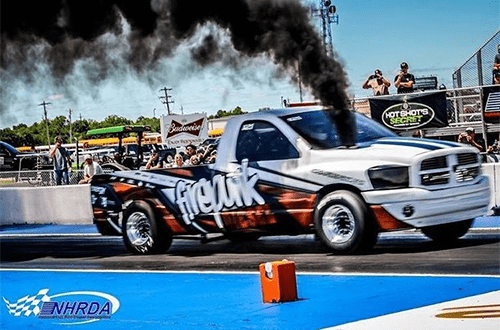
As Title Sponsor of the NHRDA and Outlaw Diesel Super Series Pro Street class sponsor we get to interact with diesel performance enthusiasts all over the country. Some truck owners have parachutes and nitrous oxide systems; others want to get on the strip for the first time. Let’s talk about drag race truck preparation and what it takes to get on the strip!
1. Check your truck out. On the road, its good practice to inspect your truck from top to bottom every so often. If you want to get on the strip this will be the first place to start. Check for nails or screws in your tires, make sure your battery is secure, address fluid leaks, check the taillights, and even washing the body and bed off are good places to start. Before you’re allowed to race, your truck will be tech inspected by a track official. Check with the event planner ahead of time to see what you need to have done to pass tech. These inspections ensure your safety and the other racer’s safety, so don’t try to cut corners!
2. Maintenance. Corresponding inspecting your truck in the step above, make sure to keep up on your truck’s maintenance. Make sure your coolant recovery or catch can is installed and check your neutral safety switch. Basic maintenance will be more than enough: fresh fluids, tires free of dry rot and cracks, brakes in optimal condition, etc. You drove the truck there under its own power, a tow truck home could cost more than getting onto the track.
3. Leave the sandals at home. While you don’t need a top of the line fire suit with matching racing shoes; make sure you wear comfortable, but proper clothing. Tennis shoes, pants, and long sleeve shirts are a good starting point and will keep you from running out to a store. If your truck is running 13.99 seconds or quicker in the quarter mile, you’ll need to shop for a helmet. NHRDA requires a recent SNELL approved helmet or an SFI rated helmet. Pack some tools, gas can, tire pressure gauge and some snacks.
4. A dose of Diesel Extreme. We know what you’re thinking; how can a fuel additive help prepare for a race? Diesel Extreme will ensure the fuel entering your combustion chamber is optimized for burn by addressing fuel quality issues like low cetane and moisture. Overtime, carbon deposits from burnt fuel and other foreign particles can form on the tips of your injectors, affecting how the fuel enters the chamber. This sounds miniscule but these deposits can affect everything from power output to emissions. Manufacturers spend countless money and time to research and test fuel spray pressure, speed, breakup length and pattern only for it to be thrown off by these deposits. A quick dose of Diesel Extreme every six months will ensure your fuel system is ready to go.
5. Lose the weight. Don’t worry, this step does not require a treadmill. Remove the spare tire and any tools you might have in the toolbox or behind your seat. Make sure you bring the jack, spare and some tools to the track, but remove them in the pits. Each time you need to leave the pits ensure there’s no loose junk in the cab that might move or roll; water bottles make their way under pedals more often than you’d think! Have your fuel tank at roughly a quarter capacity. If you installed aftermarket wheels consider their weight with the factory wheels you have in the shed.
6. Ready to roll. Make sure to have your AC and other accessories turned off. Roll the windows up and make sure your seat belt is tight. You’ll typically have better traction on all seasons if your truck is in 4×4; pick a setting and be sure to be in it before getting up to the line. If you’re in 4×4 drive around the water box; if racing in 2WD feel free to drive around the water, back up into it and spin the tires. Street tires or DOT legal drag radials do not have much to benefit from the burnout, but how many other places are you allowed to do one? Talk to drivers that are faster than you and take notes; his modifications or even tire pressure could help lower your time.

